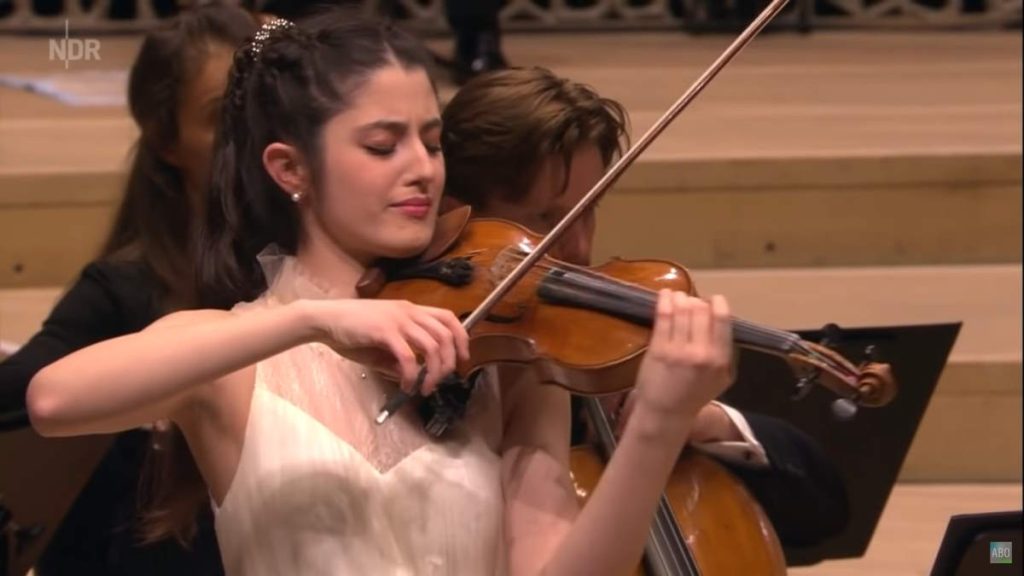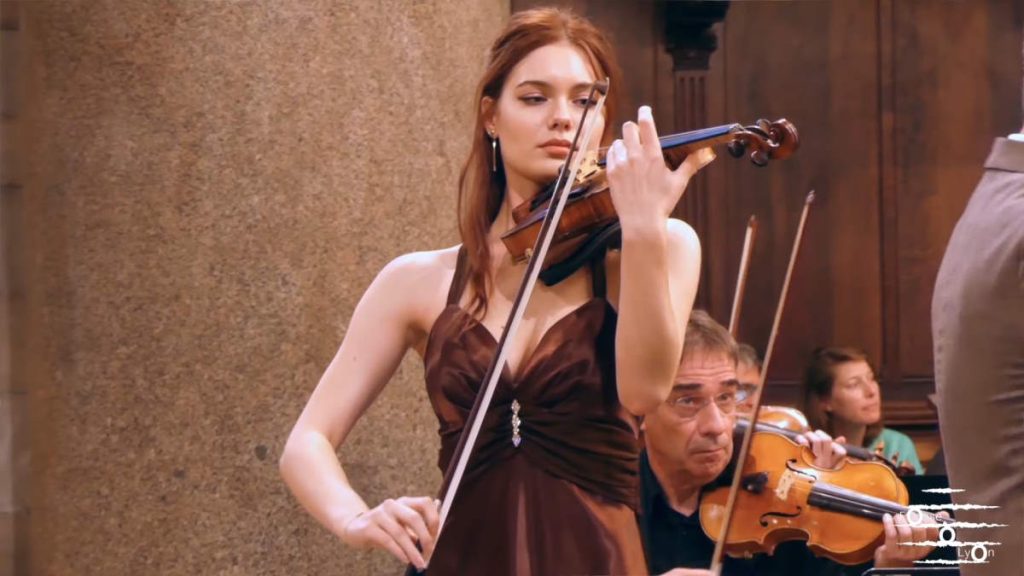Accompanied by the Royal College of Music Symphony Orchestra, the Turkish violinist Deniz Şensoy performs German Romantic era composer Max Bruch’s Violin Concerto No. 1 in G minor, Op. 26, one of the most popular violin concertos in the classical repertoire. Conductor: Martyn Brabbins. This performance was recorded at The Royal College of Music’s Amaryllis Fleming Concert Hall in London on November 1, 2024.
Max Bruch’s Violin Concerto No. 1
Max Bruch’s Violin Concerto No. 1 in G minor, Op. 26 is one of the most beloved pieces in the violin repertoire, celebrated for its lyrical beauty and virtuosic demands. The concerto was first completed in 1866, with its initial performance given on April 24 of that year by Otto von Königslow, conducted by Bruch himself. However, this initial version underwent significant revisions, with guidance from the eminent violinist Joseph Joachim, to refine the work’s structure and balance. The revised version, which is the form we know today, premiered in Bremen on January 7, 1868, with Joachim as the soloist and Karl Martin Rheinthaler conducting.
The concerto is structured in three movements, played without pause, creating a continuous and seamless musical narrative. The first movement, Vorspiel (Prelude): Allegro moderato, begins with a slow, almost improvisatory introduction that segues into a dramatic and fiery section, setting the stage for the soloist. This prelude leads directly into the second movement, Adagio, a lyrical and emotional centerpiece that showcases the violin’s singing quality, often considered one of the most beautiful slow movements in the repertoire. The finale, Finale: Allegro energico, is a lively and dance-like conclusion, filled with rhythmic vigor and virtuosic brilliance.
The work is scored for a solo violin and a standard classical orchestra, comprising two flutes, two oboes, two clarinets, two bassoons, four horns, two trumpets, timpani, and strings. This orchestration provides a rich but balanced accompaniment that allows the solo violin to shine.
Bruch’s concerto combines Romantic expressiveness with a strong sense of structure, blending dramatic contrasts with lyrical beauty. Despite Bruch’s initial frustration that this work overshadowed his other compositions, the concerto remains a testament to his melodic genius and sensitivity to the violin’s capabilities. Today, it continues to be a favorite of performers and audiences alike, offering an enduring showcase of technical skill and emotional depth.
Movements
1. Vorspiel: Allegro moderato (in G minor)
The first movement of Max Bruch’s Violin Concerto No. 1 in G minor, Op. 26, titled Vorspiel: Allegro moderato, is both structurally and musically unique. Unlike traditional concerto openings, this movement functions as a prelude (Vorspiel) to the lyrical second movement, creating an uninterrupted flow of music.
The movement begins with a slow, solemn orchestral introduction, with the initial melody introduced by the flutes. This atmospheric opening sets a reflective and mysterious tone. The solo violin soon enters with a brief, expressive cadenza that adds a dramatic flair to the orchestral texture. The introductory section is then repeated, reinforcing the mood and preparing the listener for the main themes.
The core of the movement features two contrasting themes. The first theme is bold and assertive, highlighting the violin’s technical agility and dynamic range, while the second theme is lyrical and melodic, showcasing Bruch’s Romantic sensitivity. The interplay between these themes allows the soloist to demonstrate both virtuosic brilliance and expressive depth.
The movement concludes as it began, with the solo violin presenting two brief cadenzas, now more technically demanding and intricate. The orchestra’s final tutti emerges seamlessly from the violin’s cadenzas, building tension and anticipation. The movement concludes not with a decisive ending but by transitioning directly into the second movement. This connection is achieved through a single low note sustained by the first violins, creating a seamless bridge and emphasizing the work’s cohesive design.
2. Adagio (in E-flat major)
The second movement of Max Bruch’s Violin Concerto No. 1 in G minor, Op. 26, titled Adagio, is widely regarded as the emotional core of the concerto. Set in E-flat major, this movement exemplifies Bruch’s mastery of lyrical composition, offering a profound contrast to the dramatic prelude of the first movement.
The Adagio opens with a lush orchestral introduction that establishes a warm and serene atmosphere. The solo violin soon enters, presenting a soaring, songlike melody that captivates with its emotional depth and expressiveness. This primary theme, often described as one of the most beautiful in the violin repertoire, is imbued with a Romantic sense of longing and introspection.
The orchestra plays a vital role in this movement, providing a constantly moving, intricately woven accompaniment that enhances the soloist’s performance. Far from being static, the orchestral part introduces subtle harmonic shifts and dynamic changes that maintain the movement’s momentum and allow the music to flow seamlessly from one section to the next.
The violin’s role is both melodic and virtuosic, as it alternates between singing lines and more elaborate passages. Themes are developed and revisited, allowing the violinist to explore a wide range of tonal colors and emotional nuances. The interplay between the soloist and the orchestra creates a sense of dialogue, as though the violin is engaged in an intimate conversation with the ensemble.
The movement concludes with a gentle and reflective closing, leaving the listener with a sense of tranquility and anticipation. This Adagio is not merely a respite between the energetic outer movements but a powerful and heartfelt centerpiece that showcases Bruch’s lyrical genius and the violin’s expressive potential. It remains a favorite among both performers and audiences, often considered the highlight of this Romantic masterpiece.
3. Finale: Allegro energico (in G major)
The third movement of Max Bruch’s Violin Concerto No. 1 in G minor, Op. 26, titled Finale: Allegro energico, is a spirited and exuberant conclusion to the concerto. Set in G major, this movement bursts forth with energy and brilliance, showcasing both the technical prowess of the soloist and the rhythmic vitality of the orchestra.
The movement begins with an intense yet understated orchestral introduction, creating a sense of anticipation. The solo violin enters with a bold and dazzling statement of the primary theme, marked by virtuosic double stops and a dance-like character. This lively theme sets the tone for the movement, moving at a fast but controlled tempo that propels the music forward with excitement and vigor.
Contrasting this energetic main theme is a second subject, a slower and more lyrical melody that offers moments of Romantic introspection. This melody appears at intervals, providing a striking contrast to the lively dance rhythms of the primary theme. The interplay between these two themes showcases Bruch’s ability to balance virtuosity with expressiveness, creating a dynamic and engaging musical narrative.
As the movement progresses, the dance theme returns with increasing brilliance, culminating in passages of technical fireworks for the soloist. The music builds in intensity through a dramatic accelerando, driving toward the exhilarating conclusion. The violin reaches higher and higher as the tempo and dynamics increase, creating a thrilling sense of momentum.
The concerto concludes with two grand chords, delivering a powerful and triumphant ending that leaves a lasting impression. The Finale: Allegro energico is a dazzling display of energy, technical mastery, and Romantic lyricism, bringing the concerto to a fiery and jubilant close. It remains a favorite for both performers and audiences, epitomizing the brilliance of Romantic violin repertoire.
Deniz Şensoy
Deniz Şensoy, born in 2000, began studying violin with Dania Kainova at Çukurova University State Conservatory in 2006. At 14, she was awarded a full scholarship to the Bilkent University Music and Performing Arts High School, where she studied under Rasim Bagirov and graduated in 2018. That same year, she was accepted into the Hochschule für Musik, Theater und Medien Hannover in Germany, where she studied with Prof. Krzysztof Wegrzyn. Currently, Deniz continues her education at the Royal College of Music in London, studying with Mark Messenger under the prestigious “Queen Elizabeth The Queen Mother” full scholarship.
In 2019, Deniz was honored with the “Future’s Women Stars” Prize by the Istanbul Foundation for Culture and Arts. She has received numerous awards, including first prize at the 13th Mimar Sinan Young Musicians Music Competition and third prize at the 4th Gülden Turalı National Violin Competition. Internationally, she is a laureate of the Paul Hindemith 4th International Music Competition in Germany and the Andrea Postacchini 24th International Violin Competition in Italy. Deniz has also secured first prizes in solo and chamber music categories at competitions in Serbia and France, as well as a second prize at the 16th Bohdan Warchal “Talents for Europe” Music Competition in Slovakia.

In 2014, Deniz was named the “Glowing Star of the Year” and awarded the Meriç Soylu Prize for her recital at the Milli Reasürans Concert Hall, organized by İş Bank. That year, she also won third prize at the Ohrid Pearls International Music Competition in Macedonia. Deniz received the “Ahmed Adnan Saygun” scholarship from Bilkent University in 2017. She has performed in masterclasses, solo recitals, and chamber concerts across Croatia and Bosnia-Herzegovina, and has participated in festivals such as the 17th International Gümüşlük Music Festival in 2020 and the “CEV Arts Concert” at Istanbul’s Atatürk Cultural Center in 2022. Additionally, she has represented her artistry in festivals in Tatarstan and Argentina.
Deniz made her soloist debut at the age of eight with the Çukurova State Symphony Orchestra. Since then, she has performed with numerous orchestras, including the Bilkent Symphony Orchestra, Bursa Regional State Symphony Orchestra, İzmir State Symphony Orchestra, Antalya State Symphony Orchestra, Samsun State Opera and Ballet Orchestra, Karşıyaka Municipality Chamber Orchestra, Olten Philharmonic Orchestra, Başkent Chamber Orchestra, and Eskişehir Metropolitan Municipality Orchestra.
In 2014, Deniz performed as the concertmaster of the “Iguazu en Concierto” International Youth Symphony Orchestra, organized by UNESCO, at the International Music Festival in Iguazu, which over 5,000 people attended. She has also served as the concertmaster for the Doğuş Children’s Symphony Orchestra, participated in the Türksoy Youth Chamber Orchestra’s tours, and performed with the All-Star Symphony Orchestra at the CRR Concert Hall under Gürer Aykal.
Since 2014, Deniz has been a regular performer at the International Bellapais Music Festival in Northern Cyprus, where in 2016, she played N. Paganini’s Violin Concerto No. 1 with the Çukurova State Symphony Orchestra, conducted by İbrahim Yazıcı. She has also performed P. I. Tchaikovsky’s Violin Concerto with the Bilkent Symphony Orchestra and O. Messiaen’s “Quartet for the End of Time” at the Richard Jakoby Concert Hall in Germany. Deniz has appeared at major events, including the Closing Concert of the 32nd Morges Music Academy in Switzerland, the Closing Concert of the Cagliari International Music Festival in Italy, and performances at the Lower Saxony State Museum in Germany.
Deniz has worked with renowned violinists such as Maxim Vengerov, Midori Goto, Kolja Blacher, and Itzhak Rashkovsky, among others. Currently, she plays a Josef Guadagnini violin (Cremonensis, 1801) on loan from Florian Leonhard Fine Violins, thanks to the support of the Contemporary Educational Foundation (CEV) and Talent Unlimited, a charity dedicated to supporting music students.
Sources
- Violin Concerto No. 1 (Bruch) on Wikipedia
- Deniz Şensoy on the Talent Unlimited website
- Violin Concerto No. 1, Op.26 (Bruch, Max) on the International Music Score Library Project website
- Concerto for violin, No. 1 in G minor, Op. 26, Max Bruch (1838-1920) on the Notes from the Garrett website
- Violin Concerto No. 1, in G minor, Op. 26 (Max BRUCH) on the L.A. Phil website
- Violin Concerto No. 1 in G Minor, Op. 26 (work by Bruch) on the Encyclopedia Britannica website


